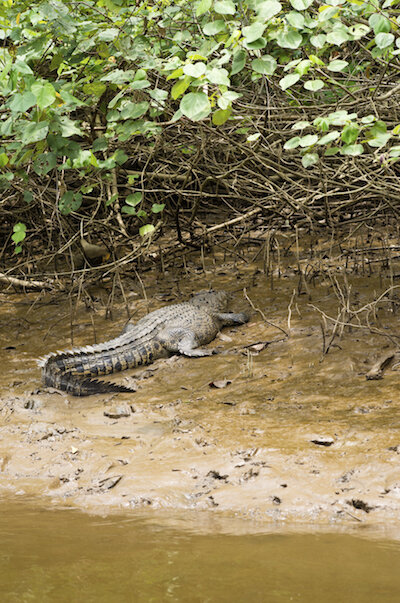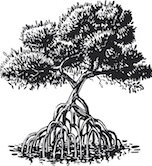Mangroves are plants that can live in salt water and in fresh water.
They live where they get both.
They have special ways of growing and getting food.
They protect the shore from being washed away by big waves.
Mangrove is also the name for a forest of mangrove plants.
Mangroves are plants that live between the sea and the land, where they are flooded by sea tides.
This is called the 'intertidal zone'.
A mangrove when the tide is in. Photo©Getty Images
The word 'mangrove' is given to either an individual species (kind) of plant or to a group of different kinds of plants, living in areas that are flooded by tides. So a mangrove may be a tree, shrub, palm, fern, climber or grass - all of them able to live in salt water.
Mangroves exist in a constantly changing environment. The sea regularly floods the area with salty water, and at low tide, especially during periods of high rainfall, there may be floods of fresh water. This quickly alters the salt levels, and can alter temperatures as well.
A sea eagle hunting for prey in a mangrove in Malaysia. Photo©Getty Images
One advantage for mangroves is that in a salty environment there is less competition because so few plants are able to thrive in those conditions. Compare this with a tropical rainforest, where there are thousands of kinds of plants all competing with each other for space, sunlight, water and nutrition.
The importance of mangroves
Mangrove trees are an important habitat for birds, mammals, crustaceans and fish by providing a breeding place and protection.
Mangrove trees are filters: they improve water quality by filtering out pollution.
Mangroves protect the shore by stabilising and improving the soil and therefore protecting shorelines from erosion.
Mangroves are an important part of the food chain for a number of animals.
A food chain is simply a sort of ‘what eats what’ line up. Mangrove plants produce a large amount of litter such as leaves, twigs. bark, fruit and flowers. Some of this immediately becomes food for creatures such as crabs, but most of it breaks down before being eaten by other creatures: bacteria and fungi break down the litter, which increases its protein, making it into food for fish and prawns. They in turn produce waste which, along with the even smaller mangrove litter, is eaten by molluscs and small crustaceans.
Materials dissolved even more feed plankton or animals such as crabs and mud whelks if they land on the mud surface.
Crocodiles are top of the mangrove food chain in Queensland, Australia. ©Getty Images
Every time the tide goes out, it takes with it a great deal of food out to sea, as much as 12,500 tonnes each year. This is dropped over a huge area of the seabed, and feeds creatures that live on the ocean bottom, as well as prawns and fish. These in turn are eaten by larger predators that may in turn be eaten themselves.
At the top of a food chain is the dominant predator in that area, such as sharks, crocodiles, humans.
Mangroves are rich in resources.
Fish, crabs, shellfish, prawns and edible snakes and worms are found there. The fruit and the nectar of some plants, including the nypa (say nip-ah) palm, can be eaten after preparation. The best honey is considered to be that produced by bees feeding in mangroves, particularly the river mangrove.
Nypa palms in Vietnam. Photo © Getty
Many traditional medicines are made from mangroves, including those for treating skin disorders, headaches, rheumatism, snake bite, ulcers and many more.
Some mangrove trees are prized for their hard wood, and were traditionally used by indigenous Australians for making tools such as spears, digging sticks and boomerangs. Nypa palm fronds are used for thatching and basket weaving.
Some barks are used for tanning or fishing floats. The wood from yellow mangroves can apparently burn even when wet.
Mangrove swamp, Daintree Rainforest, Far North Queensland. Photo©Getty Images
Mangrove Zones
Different mangrove species have different requirements. Some are more tolerant of salt than others. They have different nutrition needs. The plants are affected by wave energy, soil oxygen levels, and drainage. When a species finds its preferred conditions, it becomes stronger and more plentiful than others. This has led to quite clear zones among mangroves. The zones run parallel to the shore or to the banks of tidal creeks:
Along the sea side, there is generally an area of grey mangroves, Australia's most common mangrove. They are best adapted to a wide range of soil conditions. They are tough, and able to tolerate low temperatures and different tidal conditions. They are the ones that are generally the first to start growing on new mud banks.
The red mangrove, also known as the stilt or spider mangrove, is usually found behind this zone where its long prop roots anchor it in wind and waves.
The next zone is the part that is flooded only sometimes, at times of very high tides. The soil is firmer but saltier because of the irregular flooding: the water evaporates and leaves a coating of salt which does not get diluted until the next flooding. The yellow mangrove species are found in this zone. Conditions make it difficult for other species to survive here, other than salt marshes or succulent plants.
Further zones can see the grey mangrove again, and in less salty soil there may be a thick forest of the orange mangrove species.
Mangrove tree. Photo©Getty Images
Local conditions dictate what is found on the land side. For example, in tropical areas there may be regular flooding and freshwater swamps with less salt tolerant plants. There may be a zone of paperbark swamps as vegetation merges into rainforest. In areas of seasonal rainfall, evaporation could mean increased saltiness, so there may be a saltmarsh.
The richest mangrove communities are found in tropical and sub-tropical areas where the water temperature is over 24ºC in the warmest month, where the annual rainfall is more than 1250mm and high mountains are close to the coast, ensuring rainfall.
Mangroves need protection from high energy waves which erode the shore and prevent seedlings from becoming established. In Australia there are about 30 species (kinds) of mangrove.
Plant Survival Strategies
Salt
Mangrove forest. Photo©Getty Images
Many mangroves stop much of the salt from entering their systems by filtering it out through their roots. Some species can keep out more than 90% of salt in sea water. Others quickly pass the salt out of their systems once it has entered. Their leaves have special salt glands which pass the salt out. You can see and taste the salt coating the leaves. Still others collect the salt in their bark or in older leaves that are about to drop. Some mangroves use more than one of these methods.
Mangroves also have features that conserve water: thick waxy leaves, fleshy leaves, pores in the leaves that are sunken below the surface so that wind doesn't dry them out.
Do mangroves need salt?
Apparently not. Some species have been kept in pots where they have grown healthily and flowered regularly when given only fresh water. However, experiments have shown that the best growth occurs where the plants live in sea water diluted by about 50 per cent with fresh water.
Staying stable in unstable ground
Apart from the salt, mangroves also have to cope with being water-logged, and with unstable soils that may be lacking in oxygen.
Different mangrove plants have come up with quite similar ways of dealing with these difficulties, through their root systems.
Many mangroves have roots well above the mud when the tide is out. (kidcyber image)
Roots support a plant and take in essential nutrients and oxygen. In unstable soil, an extensive root system is needed to keep the trees upright. Most mangroves have more of the plant below the ground than above it. The main mass of roots is within the top two metres of soil, where the oxygen supply is. Cable and anchor roots provide support, and small roots come from those to collect nutrients from the surface soil. Other roots collect oxygen from the soil.
Because there is little oxygen in the mud, many mangroves raise part of their roots above the surface. These roots are covered in special breathing cells to draw in air. To avoid getting buried in the build up of soil sediment, the breathing roots can grow up vertically. Pollution is a problem : oil blocks the breathing cells and the plant can suffocate.
Some examples:
Red, stilt or spider, mangrove is subjected to high wave action and so has stilt or prop roots. These spread far and wide, providing numerous anchors for the tree as well as a large surface area for the breathing cells. Extra stilts can grow from the branches or trunk, and develop many breathing cells as soon as they reach the mud.
Grey mangrove grows peg roots, which act like snorkels.
Orange mangrove develops cable roots which have grown above the surface of the mud and then down into it again.
Looking glass mangrove has buttress roots which are like flattened, blade-like stilt roots.
A mangrove seedling. Photo©Getty Images
Spreading new plants
The fruits and seedlings of all mangrove plants can float, which is how the plant sends its seeds away to grow in another area. Generally the seeds float away and lodge in mud, where they begin to grow. Some kinds will only germinate when temperatures or salt levels are satisfactory. Some species do not drop their seeds, but begin to grow out of the base of the fruits to form long spear-shaped stems and roots that grow, attached to the parent tree, for one to three years. They reach lengths of up to a metre before breaking off the parent plant and falling into the sea. They float horizontally until they can lodge in mud in a less salty place, where they turn vertically, roots down and buds up. They then begin to grow rapidly.
Some examples:
The cannonball mangrove produces a large fruit, about 20cm in diameter containing up to 18 tightly packed seeds. When ripe, it explodes and scatters the seeds, which float away on the sea.
The seed of the looking-glass mangrove has a prominent ridge on one side. This can act as a sail when the seed is in the water.
Conservation
For many years, mangroves were cleared because people thought they were waste land that could be put to other use.
Mangrove restoration in Thailand. ©Getty
In some places serious erosion resulted along the shore from wave action. It was realised that the mangroves had for centuries been keeping the shoreline secure, and mangroves were studied and all the other ways in which they are valuable were discovered.
In some places where large areas were cleared, people are planting mangrove seedlings to restore mangroves.
Mangroves are teeming with life. These fish are part of a rich food chain both under water and above it. ©Getty Images
It’s a good idea to get information from more than one source!
Read more about mangroves
https://kids.kiddle.co/Mangrove
Watch a video about an Australian mangrove swamp
https://www.abc.net.au/education/for-the-juniors-how-do-mangrove-trees-survive/13605626













